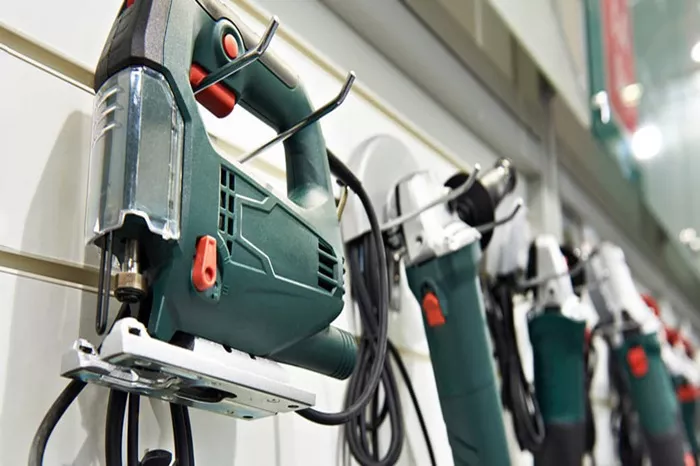Power tools are essential for DIY enthusiasts, professional tradespeople, and workshop owners. Proper storage helps extend their lifespan, maintain performance, and ensure safety. In this guide, we’ll explore the best ways to store power tools, covering ideal storage environments, organization tips, safety considerations, maintenance, electrical precautions, and space optimization strategies.
Storage Environment
Keep Power Tools in a Dry and Clean Space
Moisture and dirt are two major threats to power tools. A damp environment can lead to rust, corrosion, and electrical malfunctions. Dust and debris can clog vents, affecting the motor and cooling system. Store tools in a well-ventilated, dry space, such as a workshop, garage, or dedicated tool storage area.
Control Temperature to Prevent Damage
Extreme temperatures can negatively affect power tools. Heat can cause plastic casings to warp or crack, while cold temperatures can impact battery performance. If storing tools in a garage or basement, ensure it is insulated to prevent drastic temperature fluctuations.
Avoid Direct Sunlight and Humidity
Exposure to direct sunlight can cause fading, warping, or damage to plastic parts. Similarly, high humidity levels accelerate rusting and corrosion. Consider using a dehumidifier in enclosed storage spaces to maintain a stable, dry environment.
Organization and Accessibility
Use Pegboards for Quick Access
Pegboards are a great way to keep power tools visible and within reach. Hanging tools on a pegboard prevents clutter and saves space while allowing easy organization.
Store Tools in a Tool Chest or Cabinet
A tool chest with lockable drawers provides excellent protection from dust and moisture while keeping tools secure. Cabinets with adjustable shelves allow customization based on tool sizes.
Install Wall-Mounted Racks
For heavy or bulky tools, wall-mounted racks help keep them off the ground and prevent damage. Mounting racks near a workbench ensures tools are readily available.
Label and Categorize Tools
Grouping similar tools together makes it easier to find what you need. Labeling drawers or storage bins with the tool name and category improves efficiency in both professional and home workshops.
Safety Considerations
Keep Sharp or Heavy Tools Out of Reach of Children
If you have children at home, ensure power tools are stored in locked cabinets or on high shelves. Avoid placing sharp tools in open areas where they can pose a risk.
Secure Tools to Prevent Unauthorized Access
Unauthorized access to power tools can lead to accidents or misuse. Use locked cabinets or toolboxes with key or combination locks to prevent potential hazards.
Unplug and Store Tools Properly
When storing corded power tools, unplug them and neatly coil the power cord. This prevents accidental startup and reduces wear on the cord.
Protection and Maintenance
Use Cases or Covers to Shield Tools from Dust
Most power tools come with protective cases. If a case is unavailable, use a cover or storage bag to keep dust and debris away.
Apply Rust Prevention Techniques
For metal parts, consider using a rust-preventive spray or wiping tools with a light coat of machine oil before long-term storage. This helps protect against corrosion.
Clean and Inspect Tools Before Storage
Before storing tools, remove dust, dirt, and debris. Check for worn-out parts, frayed cords, or battery issues. Regular maintenance ensures tools stay in optimal working condition.
Electrical Considerations
Remove Batteries from Cordless Tools
For battery-powered tools, remove batteries before storage to prevent leaks and prolong battery life. Store batteries in a cool, dry place away from direct sunlight.
Avoid Tangled Cords and Chargers
Store power cords and chargers neatly to prevent damage. Use cord organizers, hooks, or designated drawers to keep them untangled and accessible.
Space Optimization
Maximize Vertical Storage
If space is limited, use vertical shelving, wall-mounted tool holders, and ceiling racks to keep tools off the ground while utilizing every inch of the workshop.
Utilize Compact Storage Solutions
Stackable bins, drawer dividers, and rolling tool carts help maximize space in small workshops.
Repurpose Everyday Items for Storage
Magnetic strips can hold small metal tools, while PVC pipe holders can be mounted on walls for drill storage. Custom-built shelving and DIY storage solutions can enhance organization without extra costs.
Conclusion
Storing power tools properly improves their lifespan, maintains performance, and ensures safety. By keeping tools in a dry, organized, and secure environment, you can prevent damage and accidents. Regular maintenance, proper labeling, and creative storage solutions help keep your workspace efficient and clutter-free. Whether you’re a DIYer or a professional, following these best practices will ensure your power tools remain in top condition for years to come.
Related topics:
- 5 Best Cordless Blowers: The Ultimate Guide
- Where Are Flex Power Tools Made?
- Which Country Made Lotus Power Tools?

